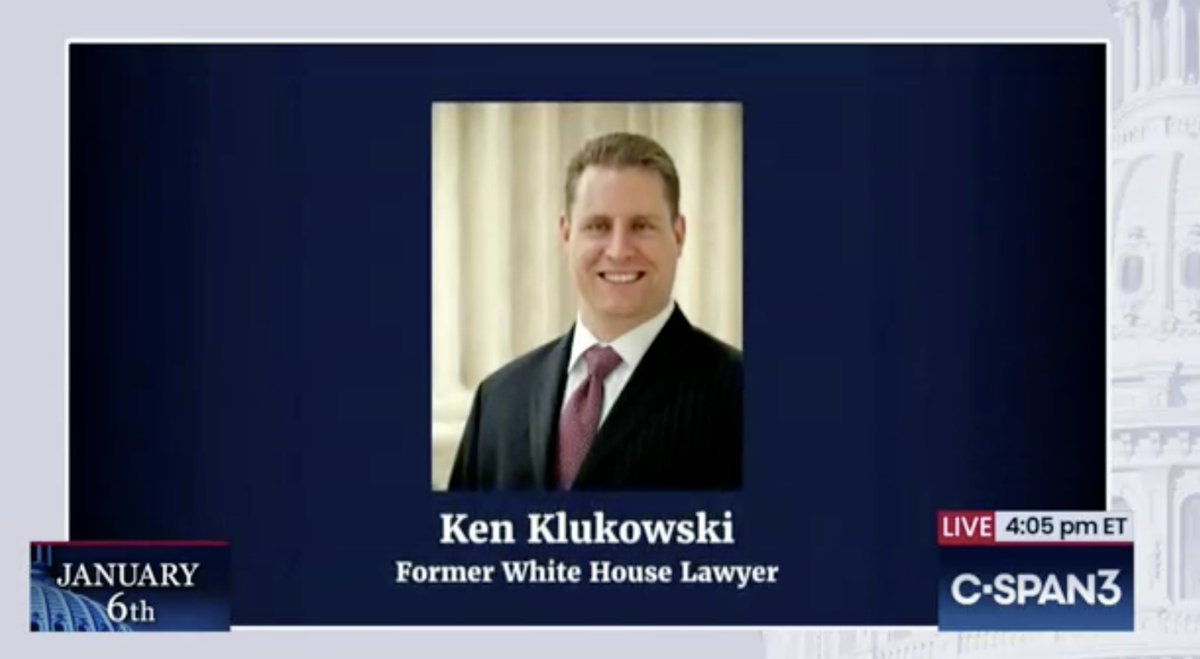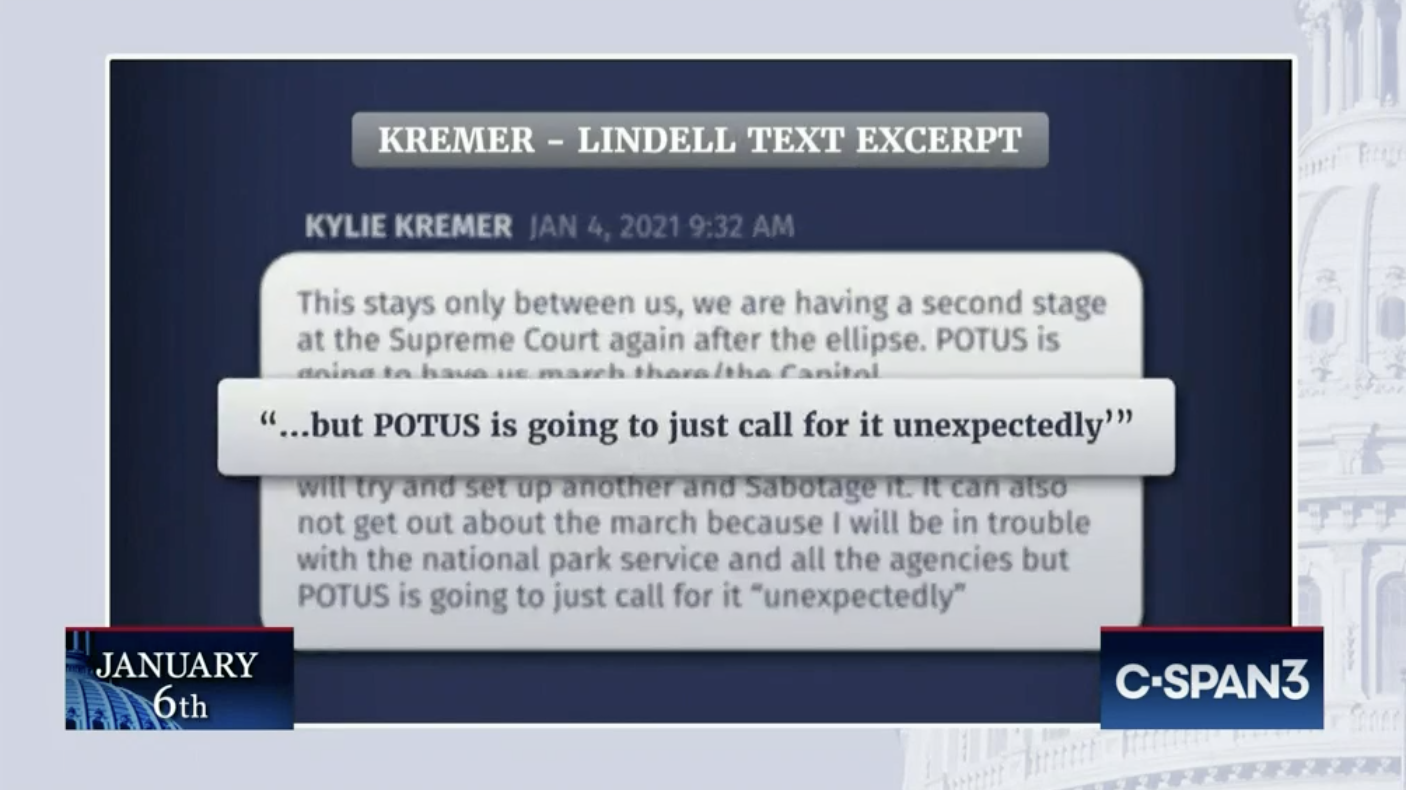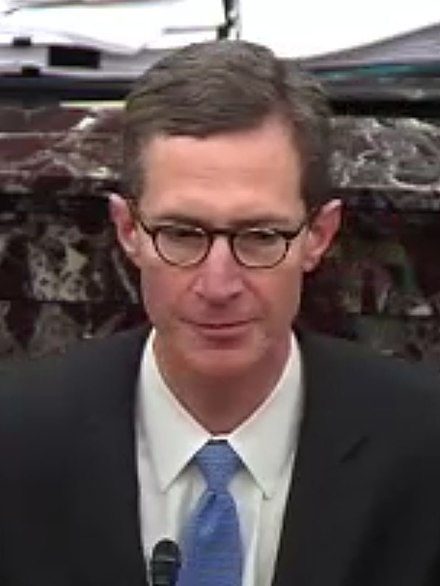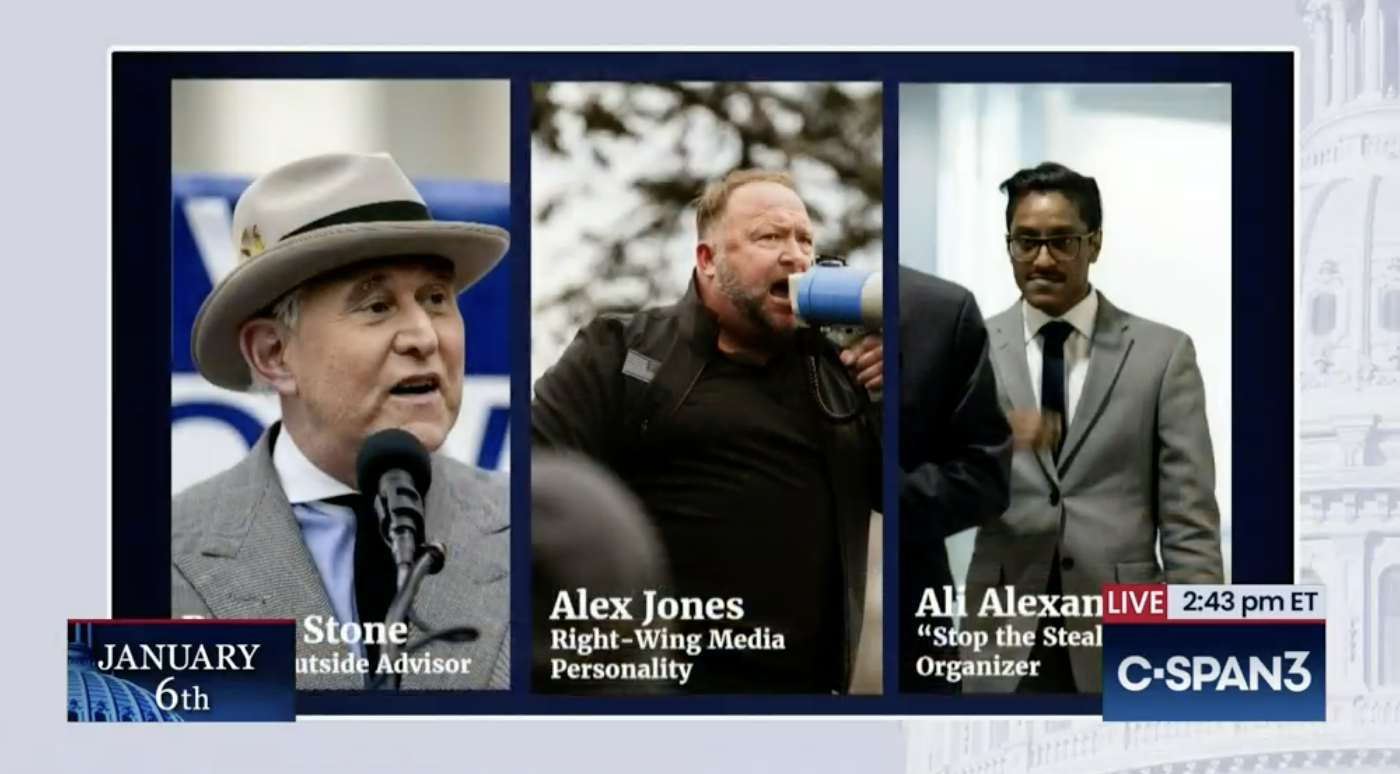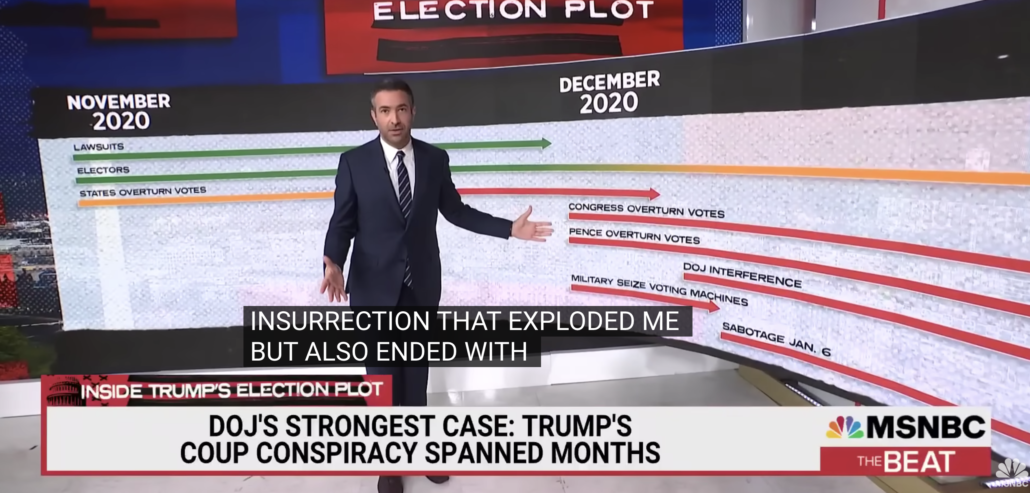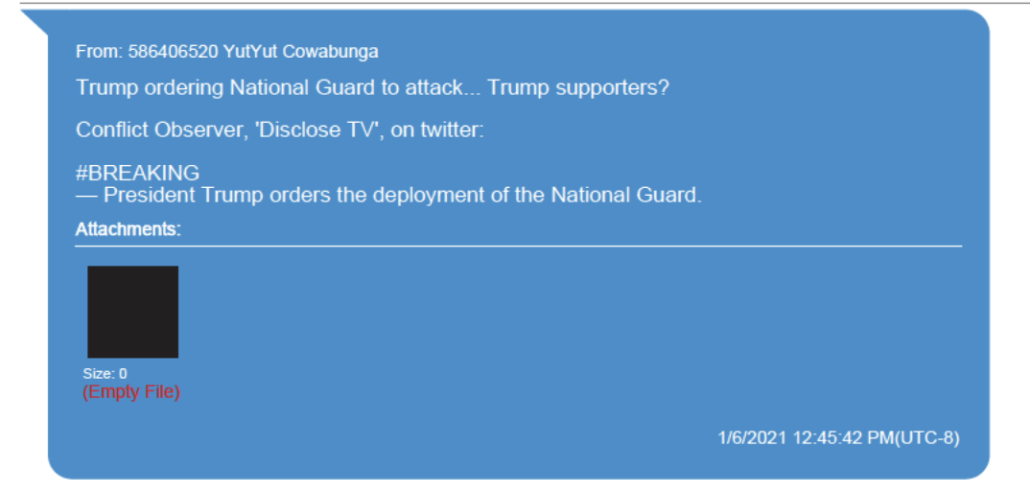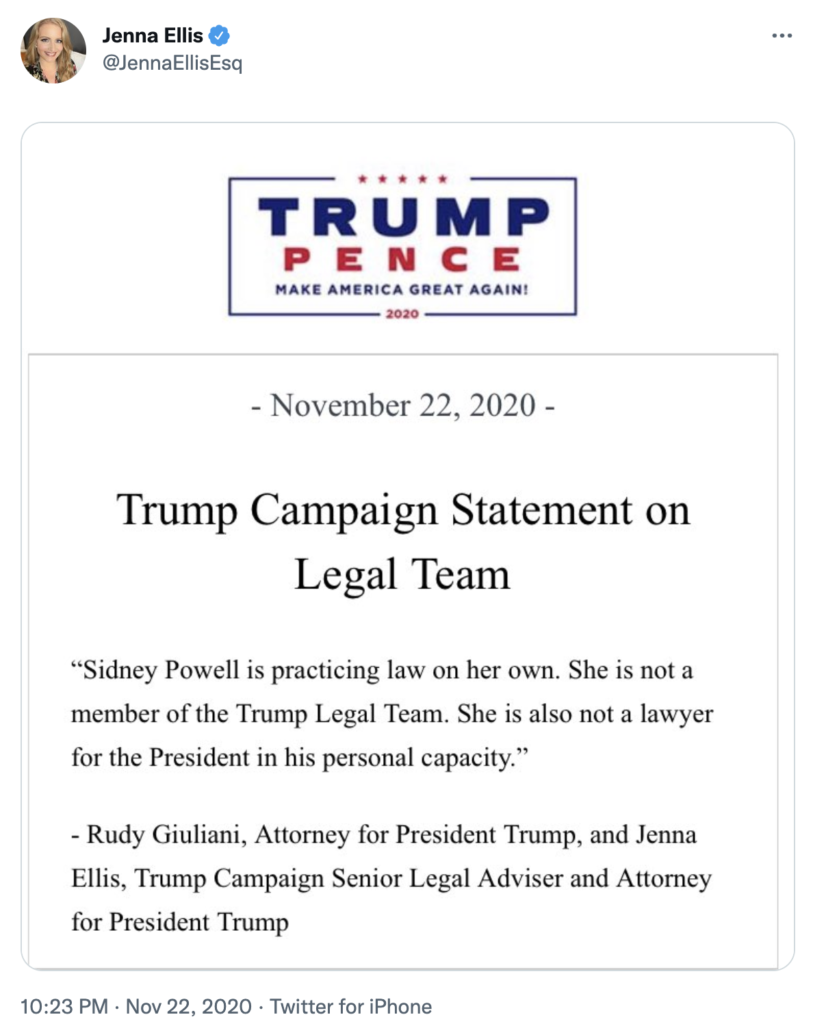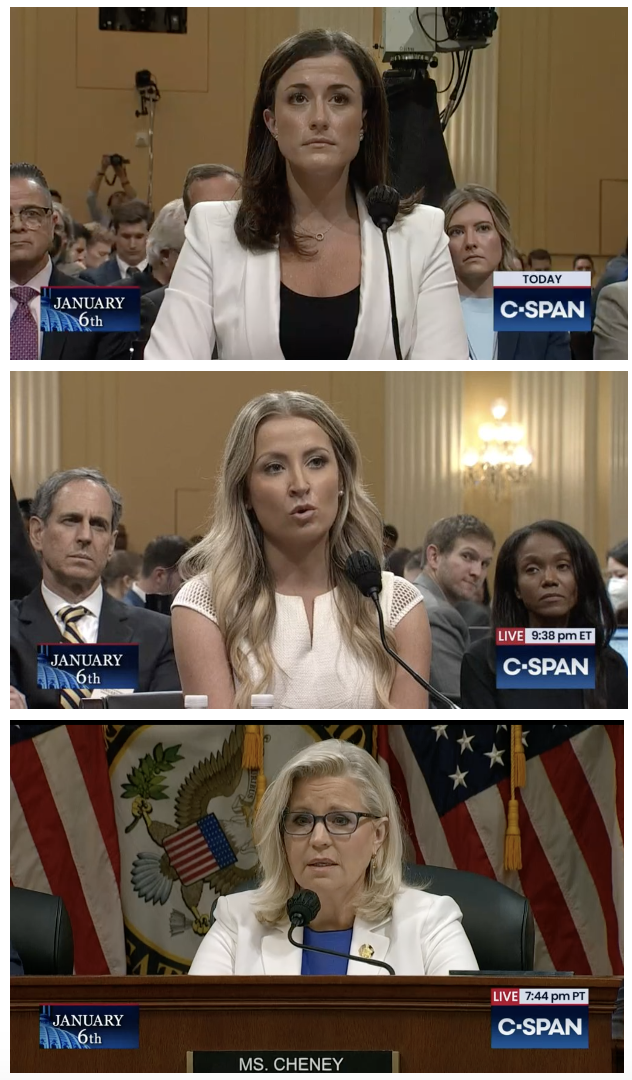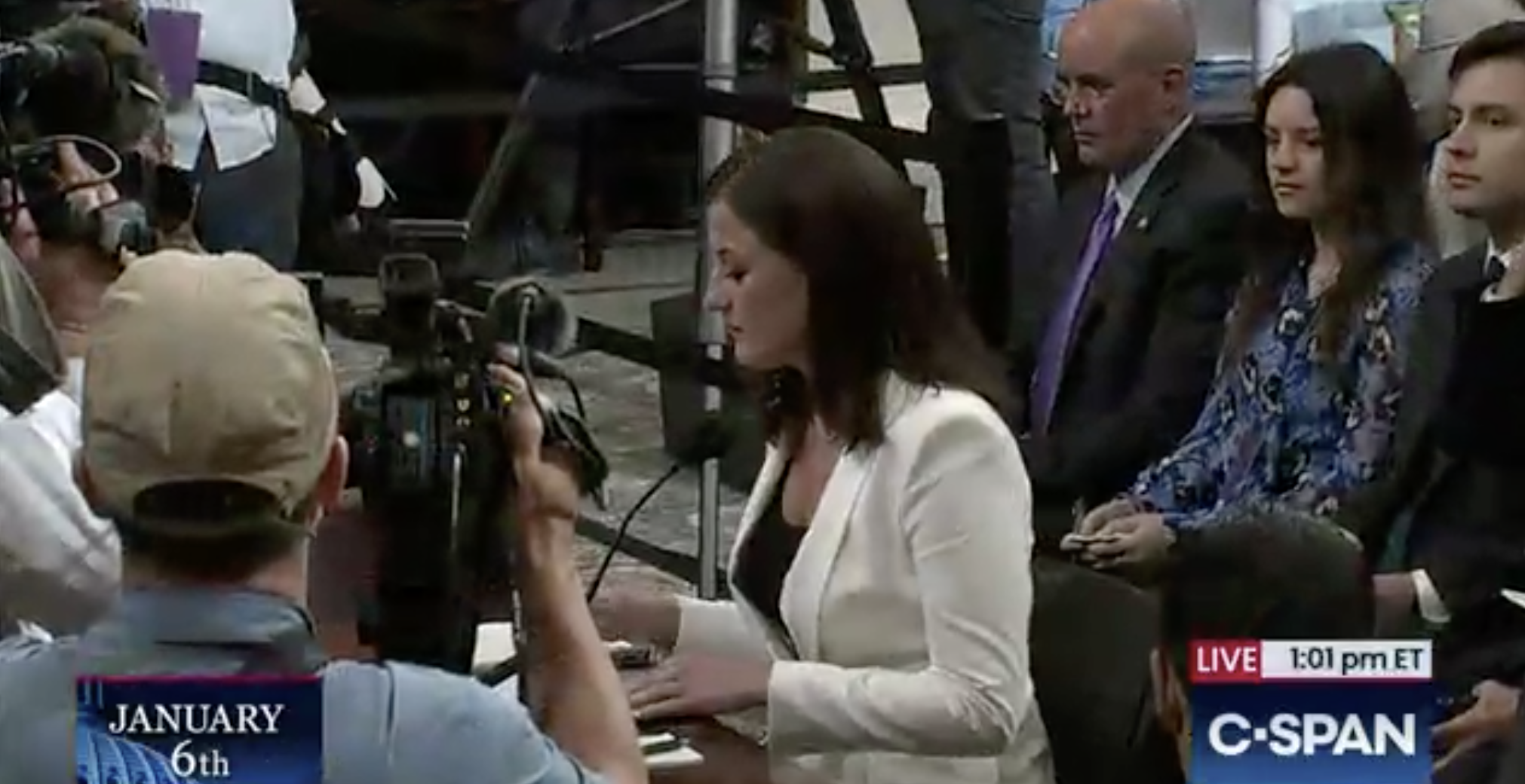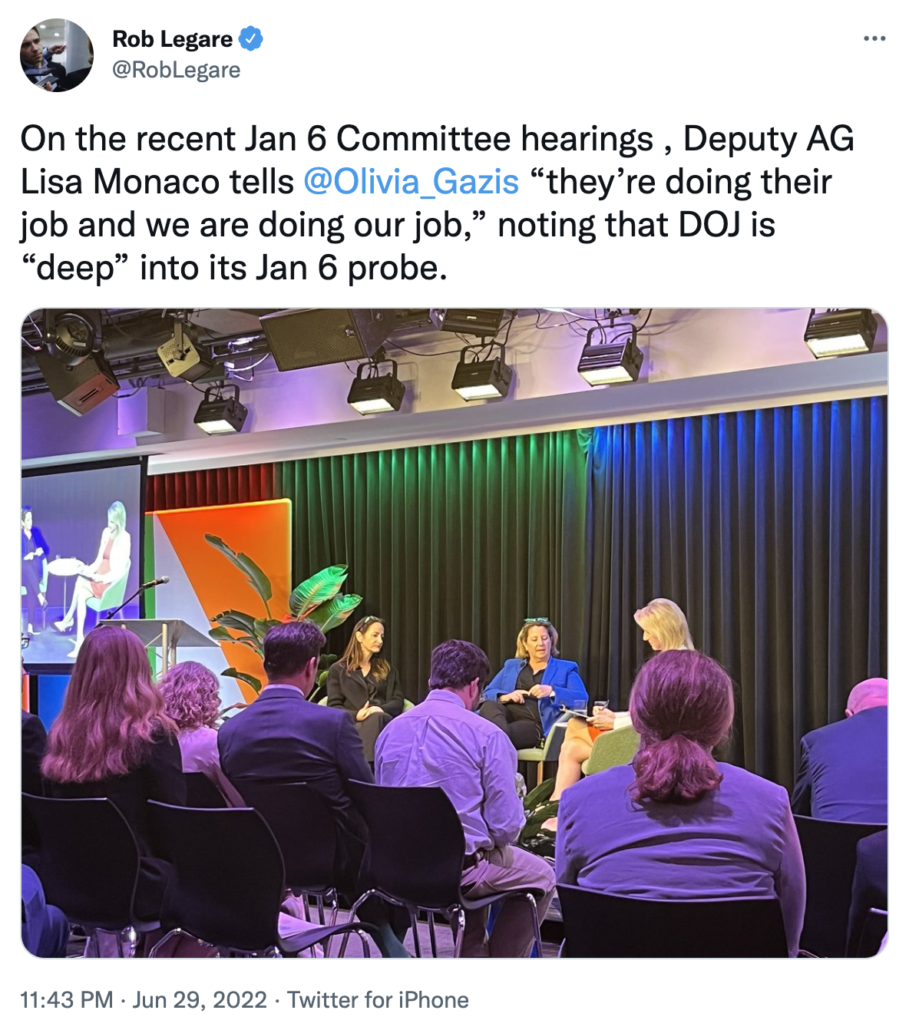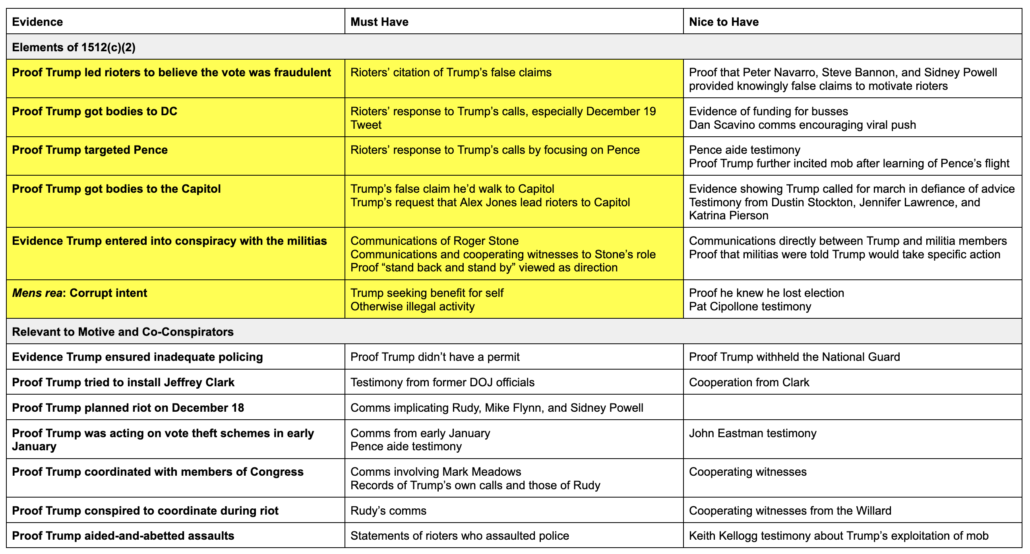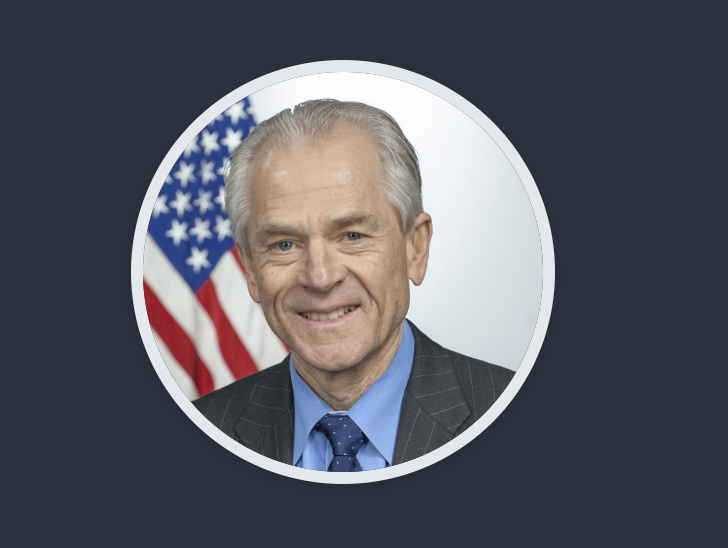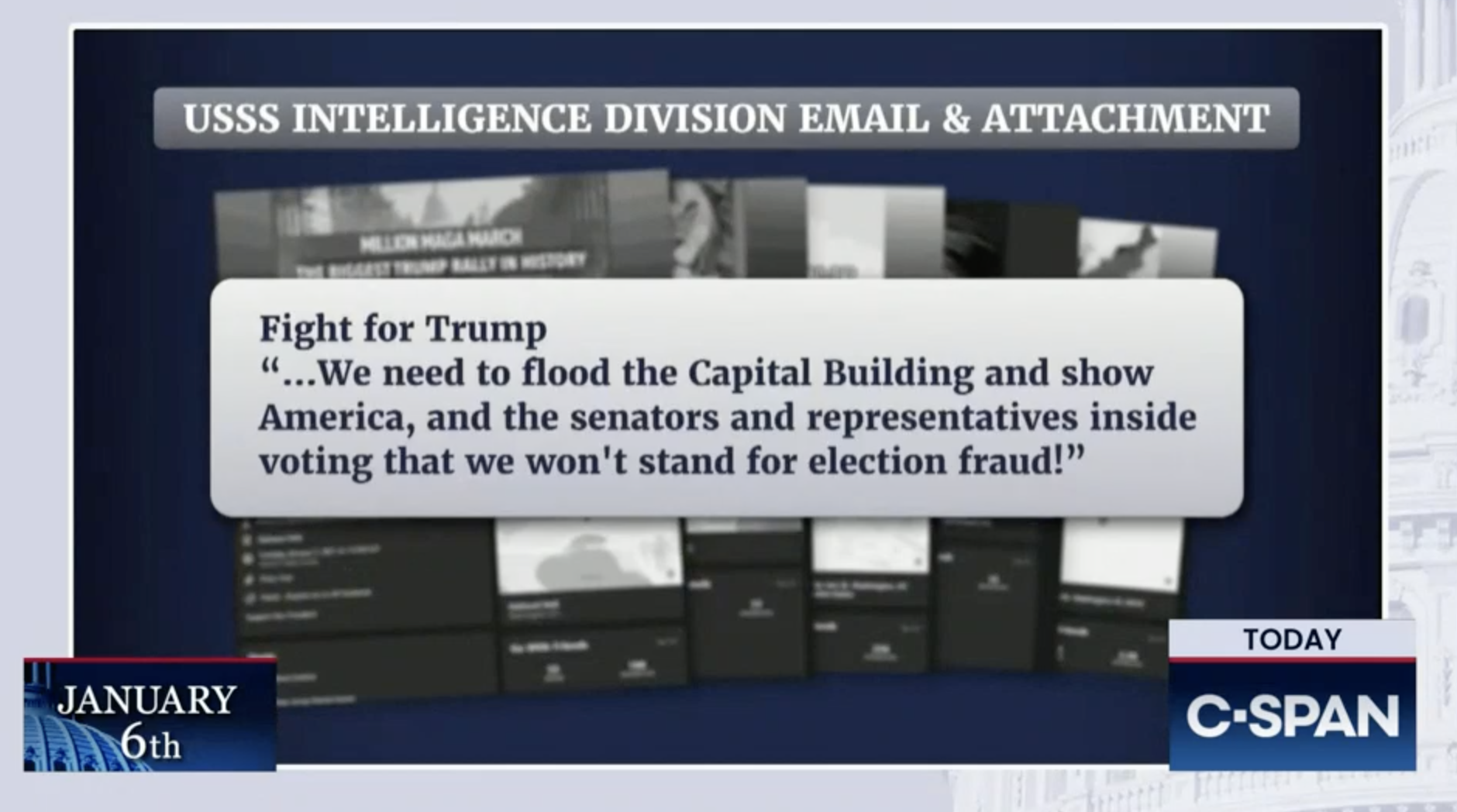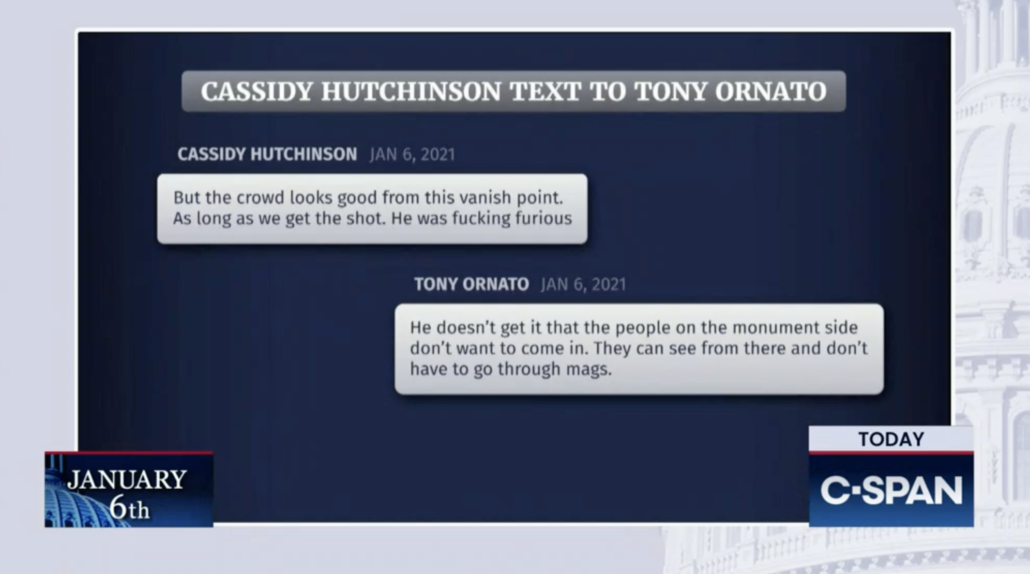Shrug: Beau Harrison’s Renewed Memory about Trump’s Lunge
One trick of trying to map the DOJ investigations into Trump onto the testimony available from the January 6 Committee is that so many Trump associates could be witnesses on so many aspects of the investigation.
I noted, for example, how Alex Cannon is a direct witness to matters pertaining to the stolen documents, Trump’s Big Lie, Trump’s misuse of money raised to combat voter fraud, and the effort to take care of Cassidy Hutchinson. When Stephen Miller appeared before a grand jury twice in eight days, did he appear on different issues, or the same? When the two Pats, Cipollone and Philbin, split a long day in grand jury rooms, were they both exclusively in a January 6 grand jury, or did they also testify before the stolen documents one?
And when three Trump aides — Dan Scavino, William Russell, and Beau Harrison– appeared before a grand jury on December 1, did they all appear before the same grand jury and for the same prong of the investigation? Their subpoenas were first reported in a NYT article that revealed the focus on Trump’s use of PAC financing. All three continued their association with Trump after he left the White House. But that doesn’t mean their testimony only relates to the financial part of the investigation. Beau Harrison’s two interviews with J6C reveal why.
I’m not aware that an interview with Russell has been released (more on him here).
Scavino refused to cooperate with J6C, for which DOJ declined to prosecute him, though the J6C report did focus on how Scavino has been paid by Save America PAC.
[F]rom July 2021 to the present, Save America has been paying approximately $9,700 per month to Dan Scavino,171 a political adviser who served in the Trump administration as White House Deputy Chief of Staff.172 Save America was also paying $20,000 per month to an entity called Hudson Digital LLC. Hudson Digital LLC was registered in Delaware twenty days after the attack on the Capitol, on January 26, 2021,173 and began receiving payments from Save America on the day it was registered.174 Hudson Digital LLC has received payments totaling over $420,000, all described as “Digital consulting.”175 No website or any other information or mention of Hudson Digital LLC could be found online.176 Though Hudson Digital LLC is registered as a Delaware company, the FEC ScheduleB listing traces back to an address belonging to Dan and Catherine Scavino.177
That leaves just Beau Harrison’s two J6C appearances (April 7, 2022; August 18, 2022).
Harrison played an Advance role in the White House and was one of several witnesses with incomplete memories about January 6 who reported to Deputy Chief of Staff Tony Ornato. In fact, Harrison shared a small office with Ornato (parts of whose unpersuasive testimony I tweeted about here).
Three things stick out about Harrison’s testimony. First, Trump’s Executive Assistant Molly Michael (who is a known witness in the stolen documents prong of the investigation and who was interviewed by the committee on March 24, 2022) named Harrison in her list of people who was employed by Save America PAC.
And how many other people from the White House staff did go onto Florida to work with him, your current colleagues or otherwise associated with the former President?
A A small handful
Q Who else was on that list besides you, Ms. Michael?
A Someone that works for the First Lady, Hayley D’Antuono.
Q Okay. She was in the White House and now works in Florida for the First Lady, correct?
A Yes.
Q Okay. Who else?
A Someone that worked in operations named Beau Harrison.
Q Okay. Mr. Harrison works for – he’s actually engaged to Ms. D’Antuono, right?
A That’s correct.
Q Okay. And what’s his role currently down in Florida?
A He continues in an operations role.
Q Okay. Are they all, like you, employed by the Save America PAC?
A Yes.
When asked about Save America in his second interview in August, here’s how Harrison answered.
Q Has anyone told you to not provide certain information, even if it’s the answer to a question that the select committee poses?
A No.
Q And then just a final set of questions. Are you receiving any assistance from anyone or entity to help cover your legal costs related to the select committee only, nothing else?
A Yes. I’m not personally — I’m not personally paying for legal representation.
Q Do you know who is, who’s covering those costs?
A Not specifically, which may be something I probably should know, but that I don’t Know.
Q Do you know what the Save America PAC is?
A Yes
Q Do you know if they have any role in helping to cover your legal costs or find somebody who would cover your legal costs?
A They — I don’t know if they are covering them. They are associated with — with whoever — whoever it may be that is.
Q Do you have a contact there who — who you talk to about issues related to this?
A The only — the only time it’s ever come up — or the only contact, you know, related to this would be when I got the initial phone call, whenever, you know, whenever, a couple months ago. whenever it was. And I contacted Justin Clark.
Like Cassidy Hutchinson, Justin Clark helped arrange for a lawyer. Like Cassidy Hutchinson, Stefan Passantino represented Harrison, including in this second interview.
A far more important part of Harrison’s testimony pertains to Trump’s reported request to be taken to the Capitol on January 6. Though the final J6C report focused closely on the story Cassidy Hutchinson first relayed about Trump lunging in his limo when informed he couldn’t be driven to the Capitol, it makes no mention of Harrison’s testimony on the issue.
In his first interview, Harrison claimed not to remember much of anything unusual about the day. The security alerts he elevated to Mark Meadows, including Ashli Babbit’s shooting, were just normal security alerts, per that testimony. Though he played a security liaison role, there was virtually nothing unusual about the day when Trump’s mob attacked the Capitol.
In that first appearance, over and over, Harrison denied recalling details of Trump’s interest in going to the Capitol. After explaining that he learned of Trump’s call to walk to the Capitol from Twitter, Harrison provided these answers about specific knowledge of discussions of Trump going to the Capitol.
Q Do you know whether Mr. Ornato or anybody else talked to the Secret Service or anyone about making arrangements for the President to goto the Capitol that day?
A I mean, I think that — again, I don’t know this for fact or specifics, but remember, you know, the – kind of the understanding was If for whatever reason it were to come up, it should be directed as with any game-time decision, it should be directed to the Secret Service, to, you know, Bob Engel or Robert Engel, you know, if that could happen.
Q Okay. And after the President said he was going to march or even shortly before, but on that day of January 6th, are you aware of those conversations or communications happening with the Secret Service or otherwise?
A No.
In his second interview, however, Harrison had a much clearer memory of Bobby Engel stopping in the office he shared with Tony Ornato than he did before Cassidy Hutchinson testified publicly in June (after she got a new lawyer to replace Passantino). In his revised memory, Harrison said that Bobby Engel described Trump “shrugg[ing] off” the instructions from Secret Service that he would not be taken to the Capitol.
Q When the President came back, do you remember Bobby Engel ever coming to your office or the office you shared with s Mr. Ornato?
A Yes
Q Tell us about that. What was he there for? What happened? What did you guys talk about?
A So as Bobby Engel normally would do, so, you know, the limo would drop off, depending on where the President was, if they were arriving on the south grounds, you know, if the President was going up to the residence, it would stop at the portico there, you know, kind of the center of the residence. If he was going the — the President was going back to his office, they would pull forward. And, you know, he could walk. There’s a little pathway from. you know, you’ve probably seen that. There was a, you know, a pathway from the drop point to the corner of the, you know, the door of the in between the Oval Office and the Rose Garden that he would use. Tony — or Bobby would be in the car with him and would, obviously, he wouldn’t go back into the Oval Office. But he would continue through the West Wing back through his office in the EEOB. You know, one of the common things that he would do would be he would, you know, pop in our office and just kind of give us an update of how the trip went or what — really anything.
And so when they got back that afternoon, again, I don’t remember the time, when they got back. I remember Bobby popped into our office. It was the three of us — Tony, Bobby, myself. And he gave an update of, you know, kind of the events there at the Capitol.
I have a memory of Bobby saying that, before the President went onstage there at the offstage announce area, you know, the whole question of should he go up to the Capitol, should he go up to the Capitol. That was kind of getting tossed around. A lot of it was — was getting directed back to Bob Engel as kind of the deciding, you know, with the events in real time, you know. Anything like that would go — would run through Bobby.
I remember Bobby, you know, saying, hey, you know, we can’t do that. You know, we have no plan for that. There are no plans to do — to do that. You know, we couldn’t — we couldn’t secure that in this amount, short amount of time, on and on like, you know, as we talked about last time. You know, further than, that he said the President went on stage, gave his remarks. And this is Bobby told Tony and myself that, you know, he was like — it was almost like he had to ask. And then when he was told that, hey, you can’t go to the Capitol, he was like, you know, kind of, again, shrugged it off and was like, all right, at least I asked. And that was it.
Now, there are a lot of ways in which this (and other parts of his) testimony conflicts with what Harrison had already said, what Engel testified to later, what records subsequently shared with the committee (and so far more readily available to DOJ) revealed.
But it’s not this conflict that I find most interesting. It’s the conflict between what Tony Ornato had to say about talking to Harrison and what Harrison had testified to months earlier.
When Liz Cheney asked Ornato whether he had spoken to anyone after Hutchinson’s testimony, he admitted speaking to the Secret Service people about Hutchinson’s testimony, but claimed that a conversation he had with Harrison was about real estate.
Ms. Cheney. Anyone else from the administration?
The Witness. I have talked to [Beau] Harrison, who has left the — Trump’s — at this point, but nothing about any testimony or anything of that nature. It was more about real estate and him moving to the area.
Ms. Cheney. Did you speak with the Secret Service spokesperson following Ms. Hutchinson’s testimony?
The Witness. I recall, that day after Ms. Hutchinson’s testimony, going to the Secret Service Counsel and being in his office and then the Secret Service spokesperson asking me about what my recollection was of that story. And I relayed that that is not a story I recollect and I don’t recall that story happening and the first time hearing it is when she had said it.
Harrison told the story differently. In an exchange just after Passantino piped in to make sure the record reflected Harrison saying that Trump “shrugged it off” rather than “shrugged his shoulders” in response to being told he couldn’t go to the Capitol, Harrison assured the committee he would know if this kind of conflict had taken place.
Q Uh-huh. so I think [redacted] had asked you about there was public reporting about a heated argument that occurred in the — and I’ll take it in two parts. First the heated argument, did you hear anything to that effect?
A No.
Q And how about what, as you said, you described, you saw Ms. Hutchinson’s testimony on TV. Is that — I want to make sure heard you correctly. Was that the first time you heard that testimony in terms of what occurred in the vehicle, as she said, relayed by Mr. Engel?
A Yes. Her — the story that was — the story that was told during her public testimony was the first I had heard of you know, anything like that being described.
Q Was there any kind of discussion, putting aside the testimony, but the days following, did you learn of anything that occurred that was more than just a back and forth of as you’re describing, of can I go and I guess Mr. Engel saying no? Was there anything in that range of more of a request, anger, heated 6 argument, altercation, anything?
A No.
Q Did you see —
A I would — I’m sorry
Q That’s okay.
A I would also add that, if something like had been described had occurred, I percent would have known about it and would have heard that.
Q And why do you say that?
A Because that is something that would have, you know — that’s — that’s the report that Bobby would share when he got — when he got back. You know, that would fall into the, hey, how’d it go and he’d be like, oh, you know. like, you know, this — this — let me tell you. But —
Q If it was shared only with Mr. Ornato, would Mr. Ornato have shared that with you?
A If it was shared with Tony, yes, Tony would have shared it with me.
Harrison similarly assured the committee, even less convincingly, that there’s no way Trump’s limo was left running to keep open the possibility of a trip to the Capitol without him knowing.
But then the committee asked Harrison, three months before Ornato would answer the same question, whether he had spoken to Ornato about this.
In addition to explaining that he’s “kind of a big brother” to Ornato’s son, Harrison revealed that Ornato called Harrison immediately after (during, maybe!?!?) Hutchinson’s testimony.
Q What about with Tony Ornato, have you talked to him about January 6th or anything that happened on January 6th before your testimony today?
A The only — the only, you know, time that we — again. Tony and I are personal friends and have talked about — you know, I’m — I’m kind of a big brother to his son and to, you know — he — we’re personal friends. The only thing that we’ve talked about on this matter is during Cassidy’s testimony, he just — he basically said, can you — you know, can you believe this? And — and that was that. You know, nothing further — nothing further. you know, was — was discussed on the matter of — aside from the fact of like, you know. where is this coming from?
Q How did he say that to you? Did he call you? Did he send you a text message?
A I believe it was a phone call. And — and I think it was more of, you know, he was like, did I — you know, did I miss something or am I — am I — you know, clearly this did not happen, but how — how is this being — you know, where is this story even coming from or, you know, where could this even, you 12 know, be coming from.
Q In that conversation, did he — he told you it didn’t happen? What portion of the testimony did he say didn’t happen in that phone call with you?
A I –well, I mean, as it was described when — you know, the whole — the whole story of — the whole story of Bob Engel returning to our office, you know, and going into the — going into the — you know, the story about the President being irate and, you know, the President grabbing Bob Engel’s neck and grabbing for the steering wheel, you know, that was the part he was like, you know — like, did that happen? Did the — you know, did that — did — was that even discussed? Was that — did that ever come up? And at that point I said —
Q In that —
A I’m sorry, go ahead.
Q Go ahead. I’m sorry. I cut you off right before you were about to say what you said in response.
A And I’m saying, no, you know, the first — the first I had even — I have ever even heard of this was. you know, just this afternoon, this afternoon when it was being described, you know, that way on TV.
Q In that conversation, did Mr. Ornato kind of relay his recollection of the events to you?
A That, I don’t remember. But, I mean, I don’t think he went, you know, play by play of what happened. I think it was mainly just kind of just, you know, kind of shock as to, you know, getting associated with and being the kind of the source of that type of information.
Harrison and Ornato could — and one day may — testify in defense of Trump at some trial. On the issue of whether he responded angrily when told he could not going to the Capitol, their testimony might just present a conflicting account to that of Hutchinson and others (and some documentary records).
But on the issue of the conversation that Harrison had with Ornato, there’s a dramatic conflict, real estate versus a direct response to Hutchinson’s testimony, possibly even as she testified.
And that’s what I mean about how interlocking all these issues are. Sure, Harrison may have been interviewed about being paid out of funds originally raised based on false claims of voter fraud.
But it’s hard to separate those payments from his evolving testimony about that shrug.
Update: At the very end of Ornato’s testimony, after learning Engel’s testimony conflicted with his and learning that Hutchinson had shared Signal texts Ornato had sent her, he described speaking to both Engel and Harrison during Hutchinson’s testimony, a clear conflict with his earlier answer about real estate.
A No, sir. The only time I had reached out to Mr. Engel was when Cassidy Hutchinson was testifying during her – as she was testifying, and I was I wasn’t watching it, was called to put it on, and I was shocked and surprised of her testimony and called Mr. Engel and asked him, What’s she talking about? And his response was, I don’t know.
And then I then proceeded to say I said, Let me listen to the rest of this now. I have no idea And that was the only time I had — I had reached out to Mr. Engel. I actually reached out to Mr. Harrison as well, because I knew Beau was in my office. And I said, Beau, what’s she talking about? And Beau said the same thing. He said, I don’t know. I don’t remember her being in your office. that was just shocked and surprised at – of the testimony, and I did reach out 9 during her testimony, I believe, to the both of them to ask that. ~ But, at that point, after I~ my head settled down, I didn’t discuss it any further.


